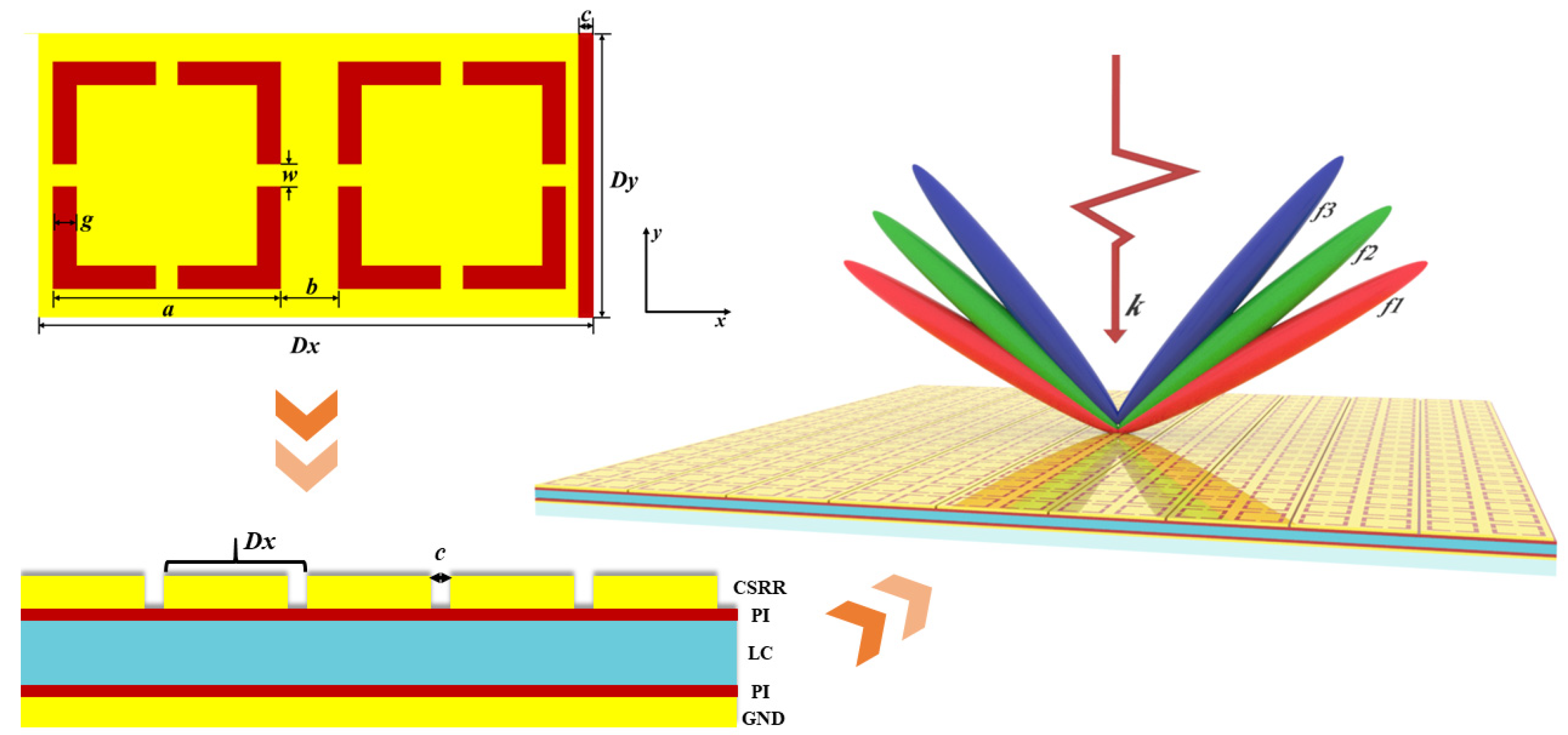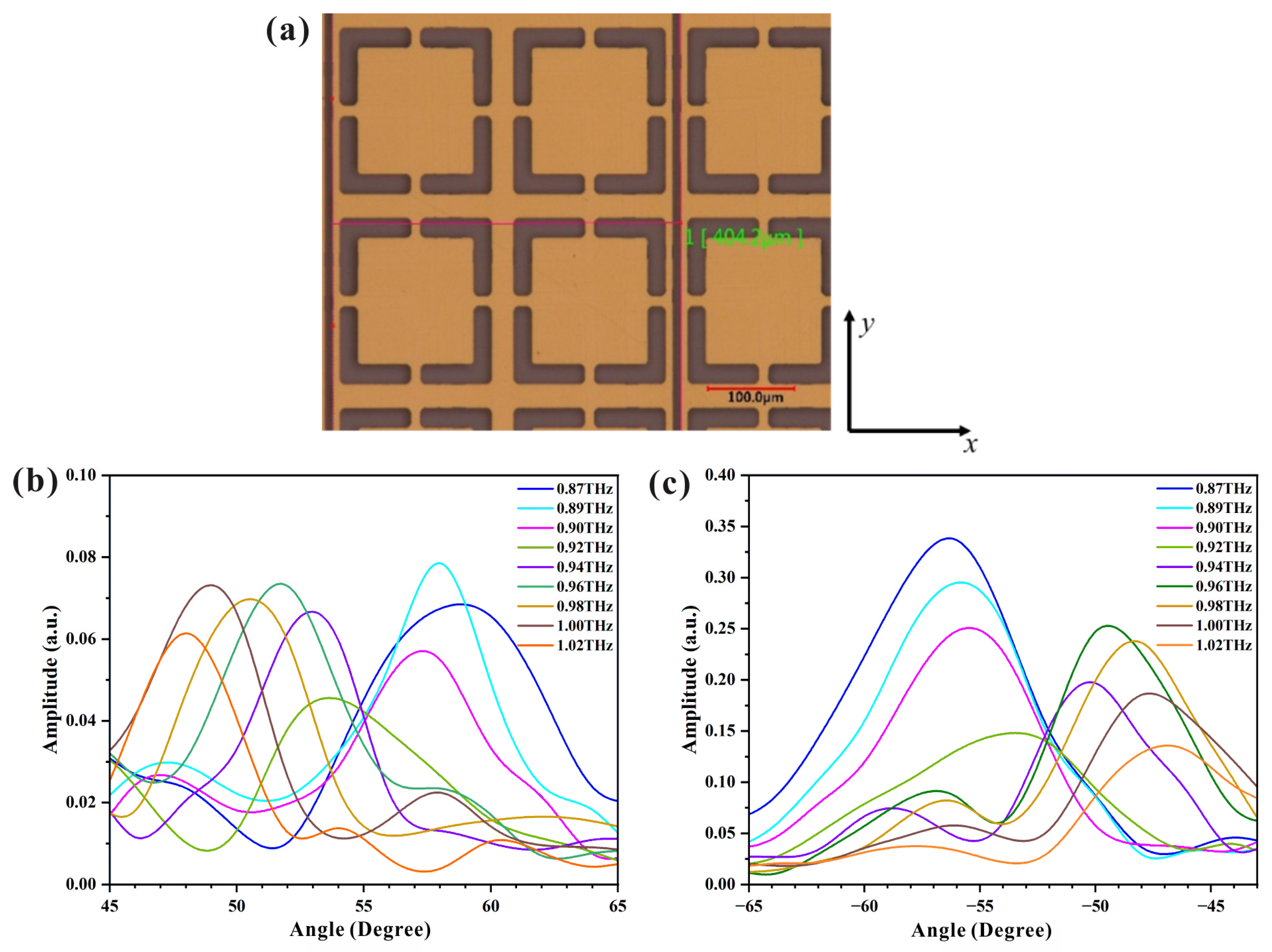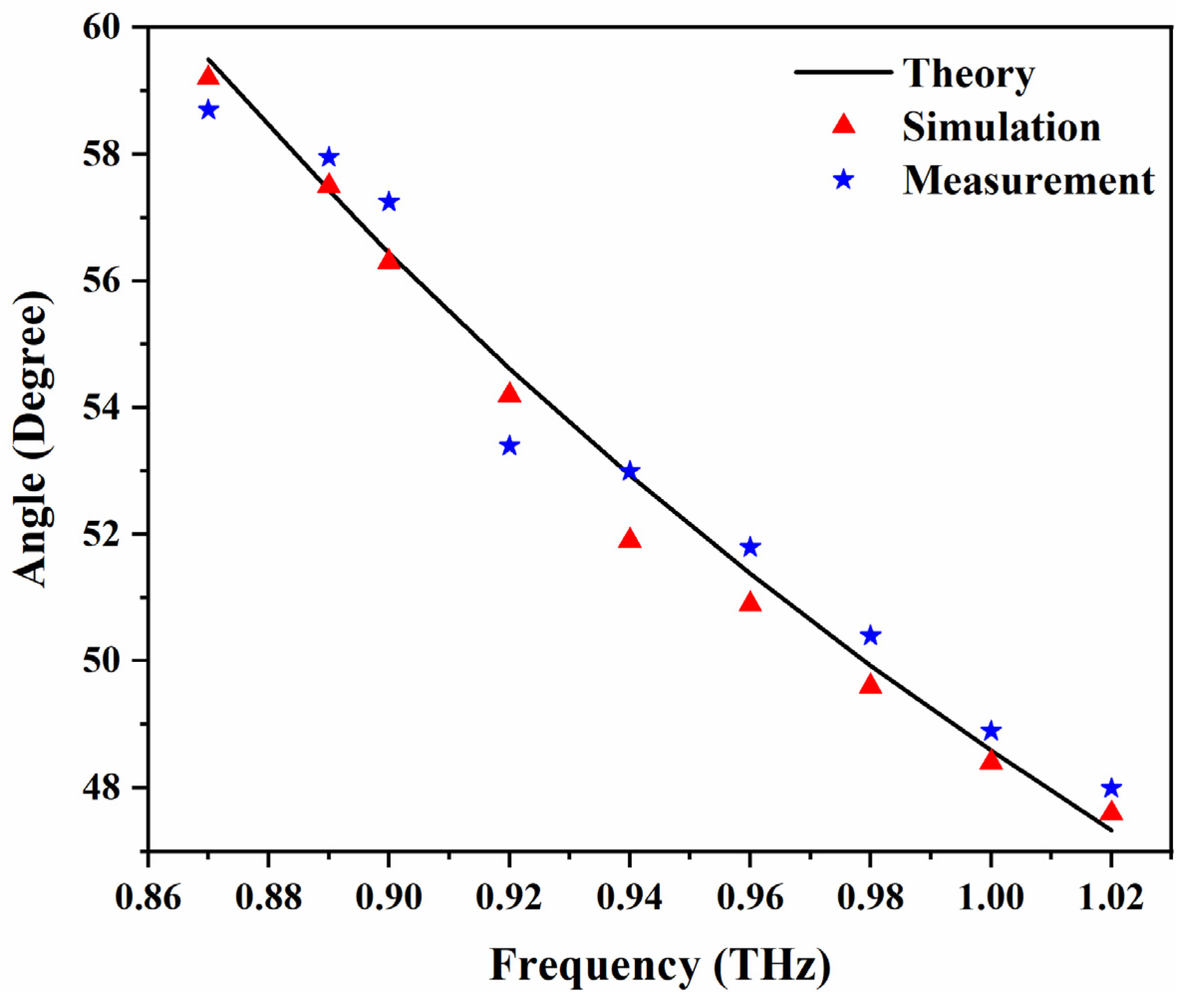Grating-like Terahertz Metasurface for Large-Deflection-Angle Beam Manipulations
Abstract
1. Introduction
2. Principle and Design
3. Results and Discussion
4. Conclusions
Author Contributions
Funding
Data Availability Statement
Conflicts of Interest
References
- Ferguson, B.; Zhang, X.-C. Materials for terahertz science and technology. Nat. Mater. 2002, 1, 26–33. [Google Scholar] [CrossRef] [PubMed]
- Moon, S.R.; Kim, E.S.; Sung, M.; Rha, H.Y.; Lee, E.S.; Lee, I.L.; Park, K.H.; Lee, J.K.; Cho, S.H. 6G Indoor Network Enabled by Photonics-and Electronics-Based sub-THz Technology. J. Lightwave Technol. 2022, 40, 499–510. [Google Scholar] [CrossRef]
- Xin, F.F.; Su, H.Y.; Xiao, Y. Terahertz Imaging System for Remote Sensing and Security Applications. In Proceedings of the 3rd Asia-Pacific Conference on Antennas and Propagation (APCAP), Harbin, China, 26–29 July 2014; pp. 1335–1338. [Google Scholar]
- Stantchev, R.I.; Yu, X.; Blu, T.; Pickwell-MacPherson, E. Real-time terahertz imaging with a single-pixel detector. Nat. Commun. 2020, 11, 2535. [Google Scholar] [CrossRef] [PubMed]
- Fan, K.; Suen, J.Y.; Liu, X.; Padilla, W.J. All-dielectric metasurface absorbers for uncooled terahertz imaging. Optica 2017, 4, 601–604. [Google Scholar] [CrossRef]
- Zaytsev, K.I.; Dolganova, I.N.; Chernomyrdin, N.V.; Katyba, G.M.; Gavdush, A.A.; Cherkasova, O.P.; Komandin, G.A.; Shchedrina, M.A.; Khodan, A.N.; Ponomarev, D.S.; et al. The progress and perspectives of terahertz technology for diagnosis of neoplasms: A review. J. Opt. 2020, 22, 013001. [Google Scholar] [CrossRef]
- Li, H.; Li, C.; Wu, S.; Zheng, S.; Fang, G. Adaptive 3D Imaging for Moving Targets Based on a SIMO InISAR Imaging System in 0.2 THz Band. Remote Sens. 2021, 13, 782. [Google Scholar] [CrossRef]
- Wu, B.; Hu, Y.; Zhao, Y.T.; Lu, W.B.; Zhang, W. Large angle beam steering THz antenna using active frequency selective surface based on hybrid graphene-gold structure. Opt. Express 2018, 26, 15353–15361. [Google Scholar] [CrossRef]
- Yu, F.Y.; Zhu, J.B.; Shen, X.B. Tunable and reflective polarization converter based on single-layer vanadium dioxide-integrated metasurface in terahertz region. Opt. Mater. 2022, 123, 111745. [Google Scholar] [CrossRef]
- Ding, C.F.; Jiang, L.K.; Wu, L.; Gao, R.M.; Xu, D.G.; Zhang, G.Z.; Yao, J.Q. Dual-band ultrasensitive THz sensing utilizing high quality Fano and quadrupole resonances in metamaterials. Opt. Commun. 2015, 350, 103–107. [Google Scholar] [CrossRef]
- Fu, X.J.; Yang, F.; Liu, C.X.; Wu, X.J.; Cui, T.J. Terahertz Beam Steering Technologies: From Phased Arrays to Field-Programmable Metasurfaces. Adv. Opt. Mater. 2020, 8, 1900628. [Google Scholar] [CrossRef]
- Qi, Y.; Zhang, B.; Ding, J.; Zhang, T.; Wang, X.; Yi, Z. Efficient Manipulation of Terahertz waves by multi-bit Coding Metasurfaces and its further application. Chin. Phys. B 2020, 30, 024211. [Google Scholar] [CrossRef]
- Larumbe, B.; Laviada, J.; Ibáñez-Loinaz, A.; Teniente, J. Real-Time Imaging with Frequency Scanning Array Antenna for Industrial Inspection Applications at W band. J. Infrared Millim. Terahertz Waves 2017, 39, 45–63. [Google Scholar] [CrossRef]
- Li, S.; Hou, P.; Zhang, P.; Hao, C.; Qu, J.; Jia, Q.; Li, G.; Li, C. Design of terahertz frequency scanning reflector antenna and its application in direction-of-arrival estimation. J. Eng. 2019, 2019, 7223–7227. [Google Scholar] [CrossRef]
- Yao, S.S.; Cheng, Y.J.; Wu, Y.F.; Yang, H.N. THz 2-D Frequency Scanning Planar Integrated Array Antenna With Improved Efficiency. IEEE Antennas Wirel. Propag. Lett. 2021, 20, 983–987. [Google Scholar] [CrossRef]
- Ding, L.; Luo, X.S.; Cheng, L.; Thway, M.; Song, J.F.; Chua, S.J.; Chia, E.E.M.; Teng, J.H. Electrically and Thermally Tunable Smooth Silicon Metasurfaces for Broadband Terahertz Antireflection. Adv. Opt. Mater. 2018, 6, 1800928. [Google Scholar] [CrossRef]
- Fan, K.B.; Zhang, J.D.; Liu, X.Y.; Zhang, G.F.; Averitt, R.D.; Padilla, W.J. Phototunable Dielectric Huygens’ Metasurfaces. Adv. Mater. 2018, 30, 1800278. [Google Scholar] [CrossRef] [PubMed]
- Gorecki, J.; Piper, L.; Noual, A.; Mailis, S.; Papasimakis, N.; Apostolopoulos, V. Optically Reconfigurable Graphene/Metal Metasurface on Fe:LiNbO3 for Adaptive THz Optics. ACS Appl. Nano Mater. 2020, 3, 9494–9501. [Google Scholar] [CrossRef]
- Ren, B.; Feng, Y.X.; Tang, S.; Wang, L.; Jiang, H.; Jiang, Y.Y. Dynamic control of THz polarization modulation and multi-channel beam generation using a programmable metasurface. Opt. Express 2021, 29, 17258–17268. [Google Scholar] [CrossRef]
- Shabanpour, J. Programmable anisotropic digital metasurface for independent manipulation of dual-polarized THz waves based on a voltage-controlled phase transition of VO2 microwires. J. Mater. Chem. C 2020, 8, 7189–7199. [Google Scholar] [CrossRef]
- Song, Z.Y.; Wei, M.L.; Wang, Z.S.; Cai, G.X.; Li, Y.N.; Zhou, Y.G. Terahertz Absorber with Reconfigurable Bandwidth Based on Isotropic Vanadium Dioxide Metasurfaces. IEEE Photonics J. 2019, 11, 4600607. [Google Scholar] [CrossRef]
- Nouman, M.T.; Hwang, J.H.; Faiyaz, M.; Lee, K.J.; Noh, D.Y.; Jang, J.H. Vanadium dioxide based frequency tunable metasurface filters for realizing reconfigurable terahertz optical phase and polarization control. Opt. Express 2018, 26, 12922–12929. [Google Scholar] [CrossRef] [PubMed]
- Qureshi, U.U.R.; Khan, M.I.; Hu, B. A Theoretical Proposal for an Actively Controlled Ultra-Wideband Absorber Based on Vanadium Dioxide Hybrid Metamaterials. Appl. Sci. 2022, 12, 10164. [Google Scholar] [CrossRef]
- Xu, K.D.; Li, J.; Zhang, A.; Chen, Q. Tunable multi-band terahertz absorber using a single-layer square graphene ring structure with T-shaped graphene strips. Opt. Express 2020, 28, 11482–11492. [Google Scholar] [CrossRef]
- Yang, J.; Chu, X.; Gao, H.; Wang, P.; Deng, G.; Yin, Z.; Lu, H. Fully Electronically Phase Modulation of Millimeter-Wave via Comb Electrodes and Liquid Crystal. IEEE Antennas Wirel. Propag. Lett. 2021, 20, 342–345. [Google Scholar] [CrossRef]
- Yang, J.; Wang, P.; Shi, T.; Gao, S.; Lu, H.B.; Yin, Z.P.; Lai, W.E.; Deng, G.S. Electrically tunable liquid crystal terahertz device based on double-layer plasmonic metamaterial. Opt. Express 2019, 27, 27039–27045. [Google Scholar] [CrossRef]
- Vasić, B.; Isić, G.; Beccherelli, R.; Zografopoulos, D.C. Tunable Beam Steering at Terahertz Frequencies Using Reconfigurable Metasurfaces Coupled With Liquid Crystals. IEEE J. Sel. Top. Quantum Electron. 2020, 26, 7701609. [Google Scholar] [CrossRef]
- Wu, J.; Shen, Z.; Ge, S.; Chen, B.; Shen, Z.; Wang, T.; Zhang, C.; Hu, W.; Fan, K.; Padilla, W.; et al. Liquid crystal programmable metasurface for terahertz beam steering. Appl. Phys. Lett. 2020, 116, 131104. [Google Scholar] [CrossRef]
- Liu, C.X.; Yang, F.; Fu, X.J.; Wu, J.W.; Zhang, L.; Yang, J.; Cui, T.J. Programmable Manipulations of Terahertz Beams by Transmissive Digital Coding Metasurfaces Based on Liquid Crystals. Adv. Opt. Mater. 2021, 9, 2100932. [Google Scholar] [CrossRef]
- Fu, X.; Shi, L.; Yang, J.; Fu, Y.; Liu, C.; Wu, J.W.; Yang, F.; Bao, L.; Cui, T.J. Flexible Terahertz Beam Manipulations Based on Liquid-Crystal-Integrated Programmable Metasurfaces. ACS Appl. Mater. 2022, 14, 22287–22294. [Google Scholar] [CrossRef]
- Tsai, Y.J.; Larouche, S.; Tyler, T.; Lipworth, G.; Jokerst, N.M.; Smith, D.R. Design and fabrication of a metamaterial gradient index diffraction grating at infrared wavelengths. Opt. Express 2011, 19, 24411–24423. [Google Scholar] [CrossRef]
- Kang, J.H.; Choe, J.H.; Kim, D.S.; Park, Q.H. Substrate effect on aperture resonances in a thin metal film. Opt. Express 2009, 17, 15652–15658. [Google Scholar] [CrossRef] [PubMed]
- Choe, J.H.; Kang, J.H.; Kim, D.S.; Park, Q.H. Slot antenna as a bound charge oscillator. Opt. Express 2012, 20, 6521–6526. [Google Scholar] [CrossRef] [PubMed]




| Incident Frequency/THz | Diffraction Angle/Degree | Incident Frequency/THz | Diffraction Angle/Degree |
|---|---|---|---|
| 0.87 | ±59.5 | 0.95 | ±52.1 |
| 0.88 | ±58.5 | 0.96 | ±51.4 |
| 0.89 | ±57.4 | 0.97 | ±50.6 |
| 0.90 | ±56.4 | 0.98 | ±49.9 |
| 0.91 | ±55.5 | 0.99 | ±49.3 |
| 0.92 | ±54.6 | 1.00 | ±48.6 |
| 0.93 | ±53.8 | 1.01 | ±48.0 |
| 0.94 | ±52.9 | 1.02 | ±47.3 |
Publisher’s Note: MDPI stays neutral with regard to jurisdictional claims in published maps and institutional affiliations. |
© 2022 by the authors. Licensee MDPI, Basel, Switzerland. This article is an open access article distributed under the terms and conditions of the Creative Commons Attribution (CC BY) license (https://creativecommons.org/licenses/by/4.0/).
Share and Cite
Fu, Y.; Fu, X.; Shi, L.; Cui, T.J. Grating-like Terahertz Metasurface for Large-Deflection-Angle Beam Manipulations. Appl. Sci. 2022, 12, 12322. https://doi.org/10.3390/app122312322
Fu Y, Fu X, Shi L, Cui TJ. Grating-like Terahertz Metasurface for Large-Deflection-Angle Beam Manipulations. Applied Sciences. 2022; 12(23):12322. https://doi.org/10.3390/app122312322
Chicago/Turabian StyleFu, Yuan, Xiaojian Fu, Lei Shi, and Tie Jun Cui. 2022. "Grating-like Terahertz Metasurface for Large-Deflection-Angle Beam Manipulations" Applied Sciences 12, no. 23: 12322. https://doi.org/10.3390/app122312322
APA StyleFu, Y., Fu, X., Shi, L., & Cui, T. J. (2022). Grating-like Terahertz Metasurface for Large-Deflection-Angle Beam Manipulations. Applied Sciences, 12(23), 12322. https://doi.org/10.3390/app122312322






